AC Milan trail Roma 1-0 following the first leg of their Europa League quarter-final at San Siro. The game’s only goal came in controversial circumstances, with a suspected offside in the attack that led to the corner kick that Gianluca Mancini scored from.
The Rossoneri may have edged the possession share (54%) and doubled their opponent’s shots (20-10), but the visitors are deserving of their advantage at the halfway point of this tie. Thirteen of Milan’s twenty shots were from outside the penalty area, highlighting Roma’s effectiveness in defending their box.
Olivier Giroud could have levelled the scoreline in the 87th minute, after good work out wide from substitute Samuel Chukwueze, but the French centre-forward only managed to hit the bar from five yards out. Post-match, both Stefano Pioli and captain, Davide Calabria, spoke of how Roma put the home team in “difficulty” in the first half.
Here to analyse just why that was, is @Tactics_Tweets to provide his tactical observations on the game.
Milan’s defensive difficulty
In the opening fifteen minutes of the game, Roma had 59% possession – their highest share of the ball than at any other stage of the match. Part of the reason for this success in retaining the ball was Daniele De Rossi clearly instructing his players on how to exploit the potential weaknesses in Milan’s defensive set-up.
Out of possession, like in recent games against Fiorentina and Lecce, Pioli’s side kept Rafael Leão higher up the pitch, alongside Giroud. In behind this forward line of two were four midfielders and a back four. Tijjani Reijnders was the player, when Milan were without the ball, who would be positioned as the left-sided midfielder.
In the visual below, from the 2nd minute, you can see the top half of this 4-4-2. Leão and Giroud positioned themselves in reference to the Roma centre-backs whilst Pulisic had the task of covering, and tracking, left-back, Leonardo Spinazzola. In central midfield, Roma used a double pivot and in this instance, Ruben Loftus-Cheek engaged Leandro Paredes and Ismaël Bennacer did the same to Bryan Cristante.
In this action, Milan were transitioning from a settled defensive shape into their player-orientated pressing scheme. The problem for the hosts came in the form of Paulo Dybala. The Argentine’s deeper positioning gave Reijnders an issue. Firstly, it delayed his jump out to right-back, Zeki Çelik, who in this passage of play was an easy out ball for Roma. And secondly, Reijnders knew if he could not stop Çelik’s forward pass then Dybala would be left free in behind.
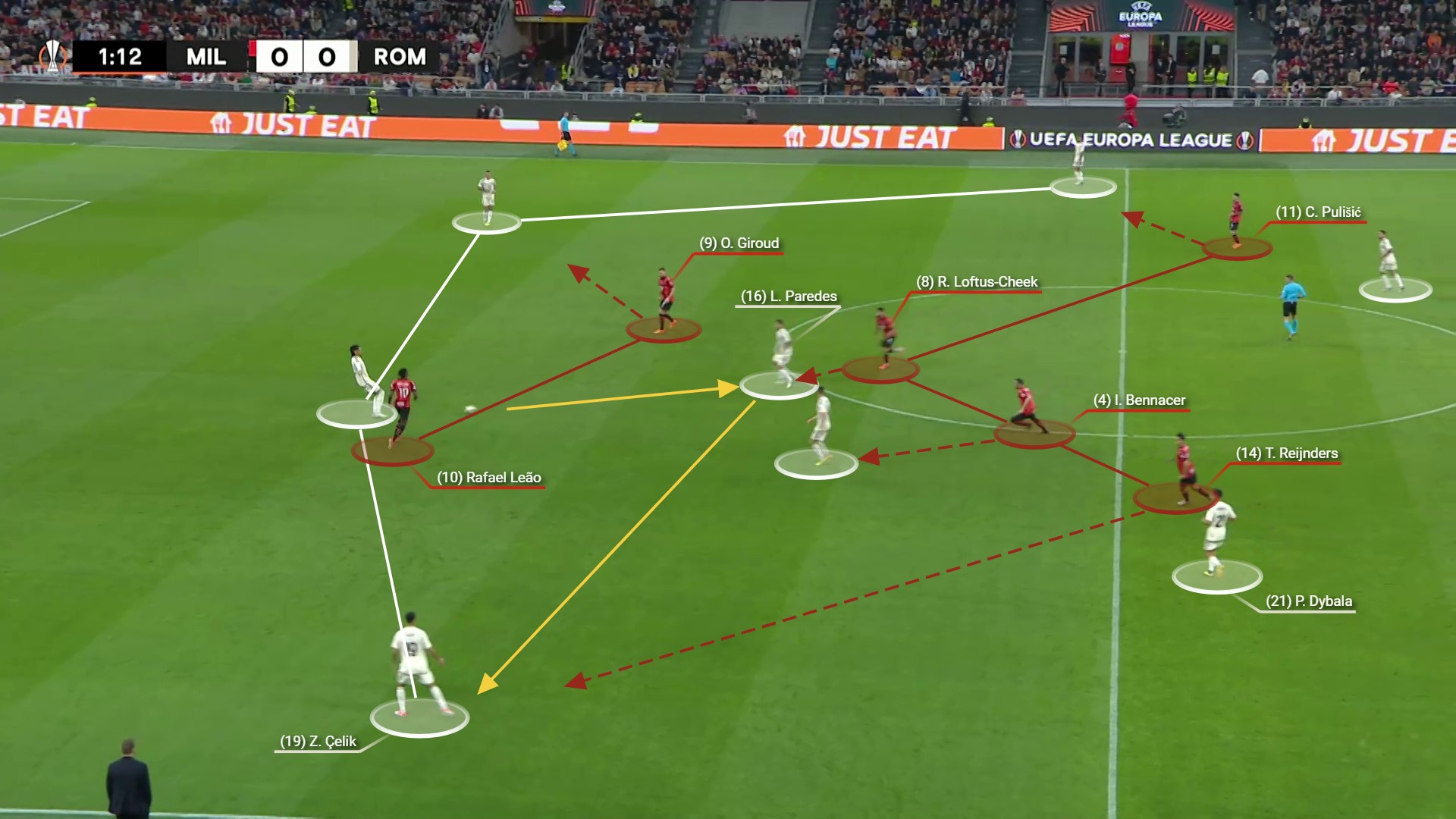
And this is exactly what happened. Dybala received between the lines, with none of the Milan backfour jumping up to cover. This is because Stephan El Shaarawy’s high and wide positioning helped pin Theo Hernández back, and Matteo Gabbia and Malick Thiaw chose to maintain a 2v1 against Romelu Lukaku. (Whilst Calabria tried to stay close to Lorenzo Pellegrini who had license to drift infield, off his left wing starting position).
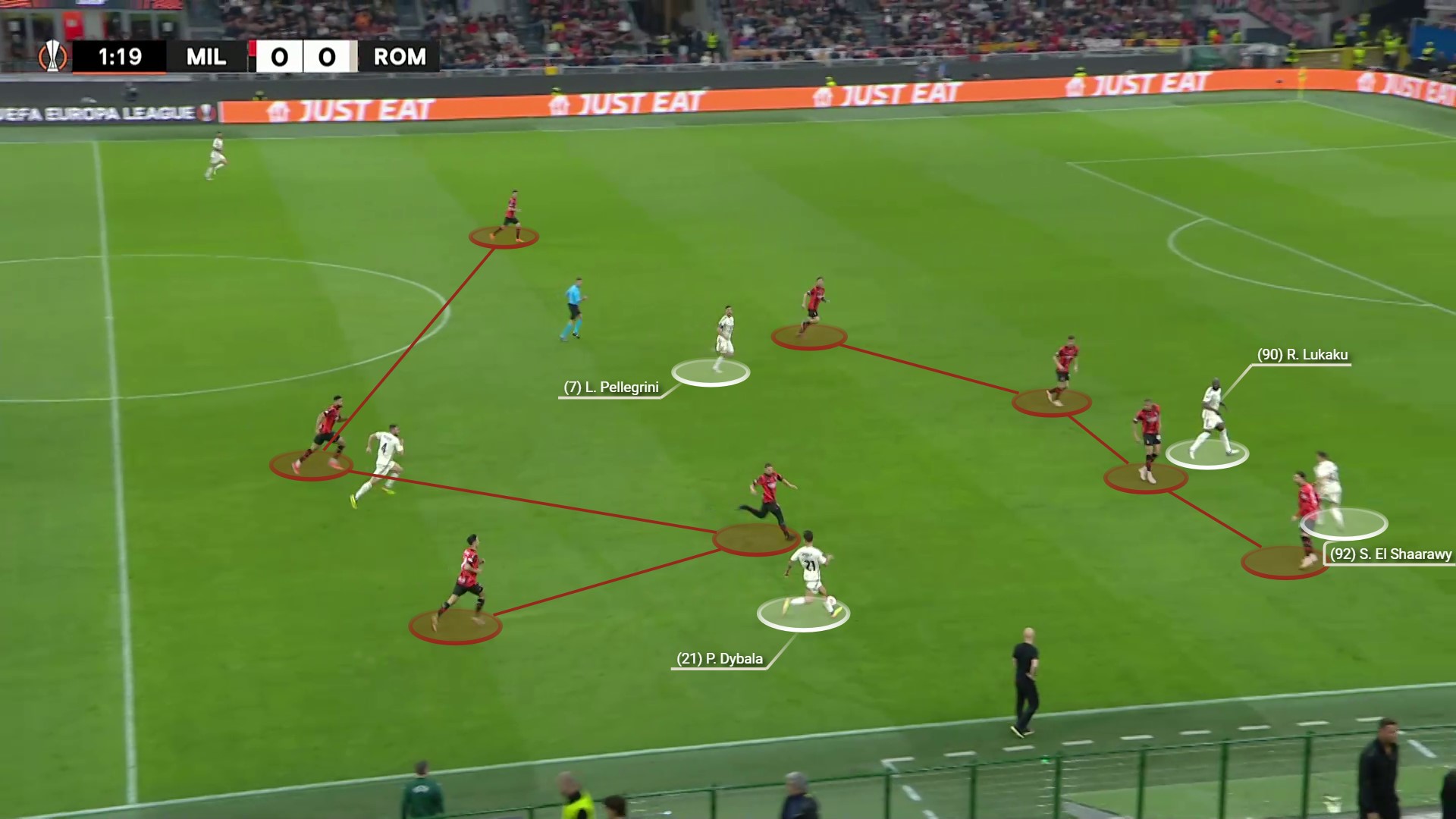
Fortunately for Milan, perhaps due to it being early in the game, Dybala opted to retain possession as opposed to attack in this moment. This enabled the home players to retreat and recover into shape whilst Roma recycled the ball backwards.
But this was just the first of many times Roma manufactured and exploited weaknesses in Milan’s defensive set-up, both when settled and pressing. And Dybala’s deeper positioning, in behind and in between the Milan midfield, was key to Roma’s attacking gameplan.
In the 4th minute, Roma worked the ball back to their goalkeeper and got into their build-up shape. As you can see, Dybala’s presence caused Bennacer to stay with him and this meant Reijnders was now responsible for covering Cristante. All of this resulted in Çelik being left completely free at right-back, but the Turkish international was not the intended target on this occasion.
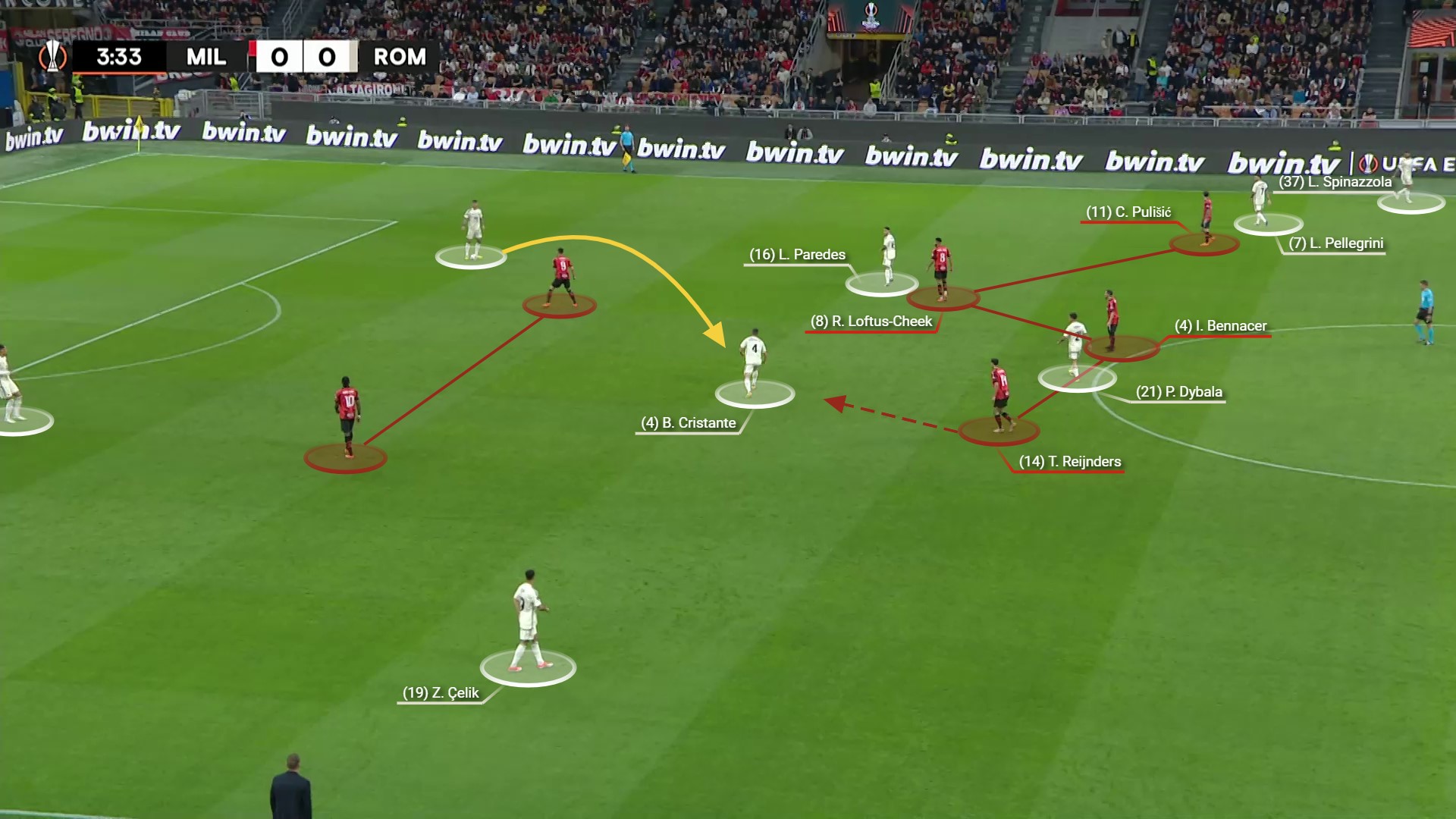
Instead, after receiving the ball, Cristante passed back to his goalkeeper and Mile Svilar decided to go long towards Lukaku who was momentarily isolated against Gabbia. From this direct attack, Roma were able to enter the Milan penalty box and have the game’s first attempt on goal.
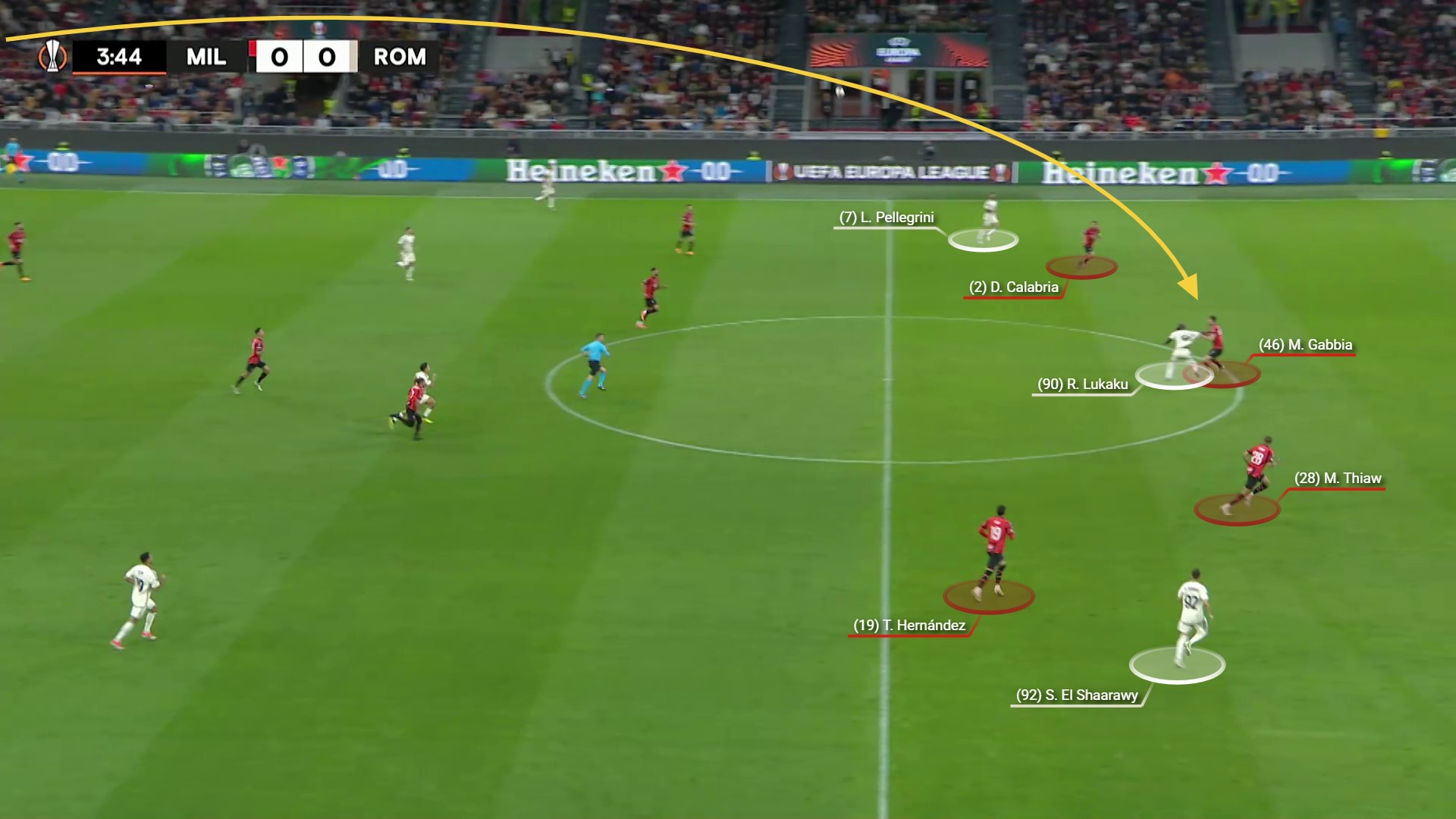
Within the first five minutes, Roma had showcased two attacking variations – 1) find the free player in build-up and progress via them and 2) go direct into Lukaku, against a depleted Milan backline, and play off their powerful Belgium striker. Key to both of these tactics being possible, and successful, was Dybala dropping deeper to overload central midfield areas.
In the 11th minute, Roma combined these two attacking tactics. Play started with a deep build-up and Paredes dropped in between his two centre-backs which dragged Loftus-Cheek up with him. With Dybala deep, Bennacer instructed Reijnders to pick up the free Cristante.

After a few Roma passes were exchanged, Reijnders nearly disposed Cristante but the loose ball fell to Paredes who was able to find the free Çelik.
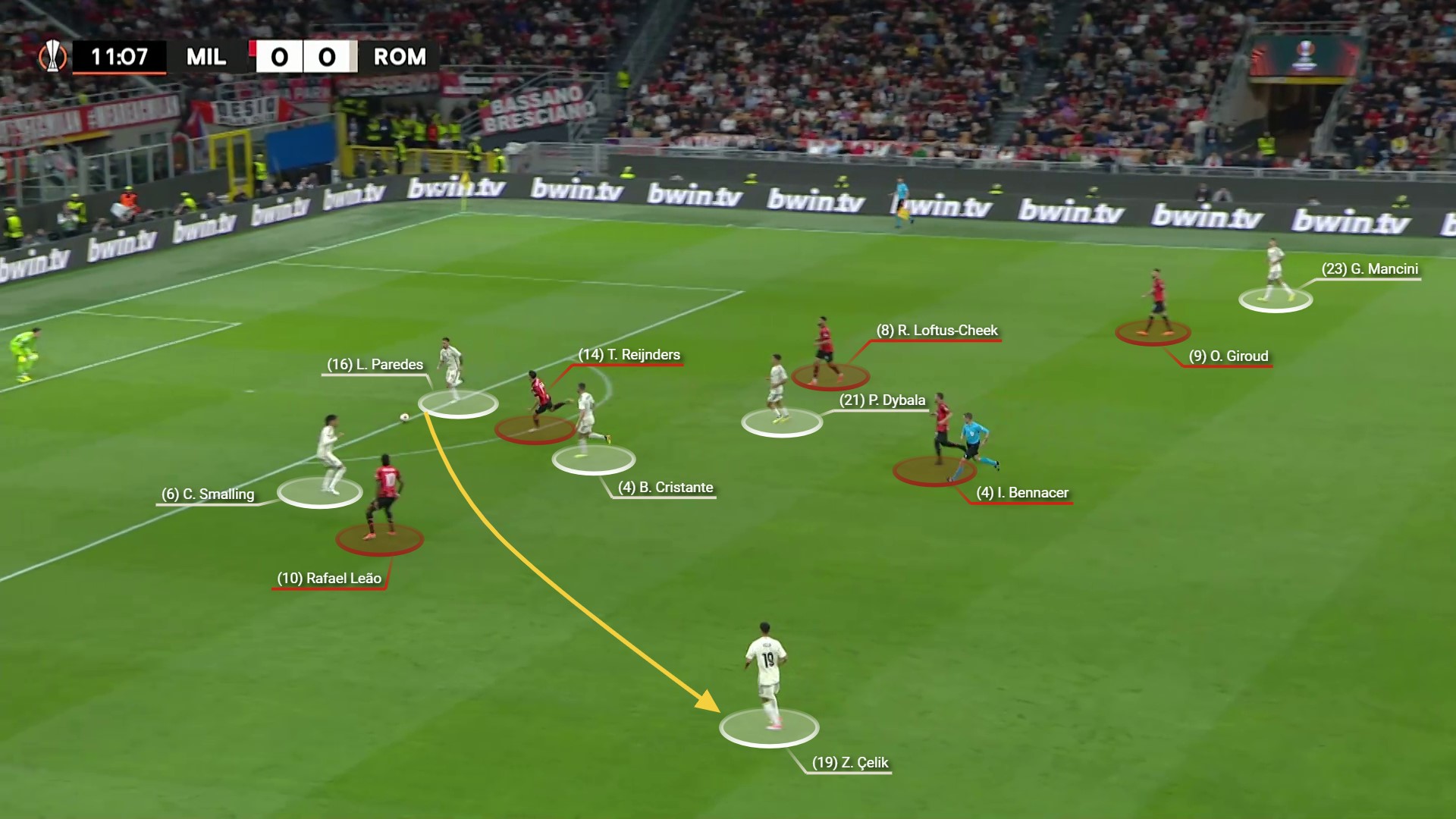
This time, Theo Hernández did jump out of the backline to close down the Roma right-back but his presence only served to force Çelik backwards. He then set the ball for Cristante to play forward…

…into the feet of Lukaku who was 1v1 against Gabbia, as Thiaw had pushed out wide to cover El Shaarawy. In this situation, Roma had a 3v3 against a depleted Milan backline and forward runners, namely Pellegrini (again, drifting in off the left) and Dybala who managed to evade the Milan markers, who had all been focused on pressing high.
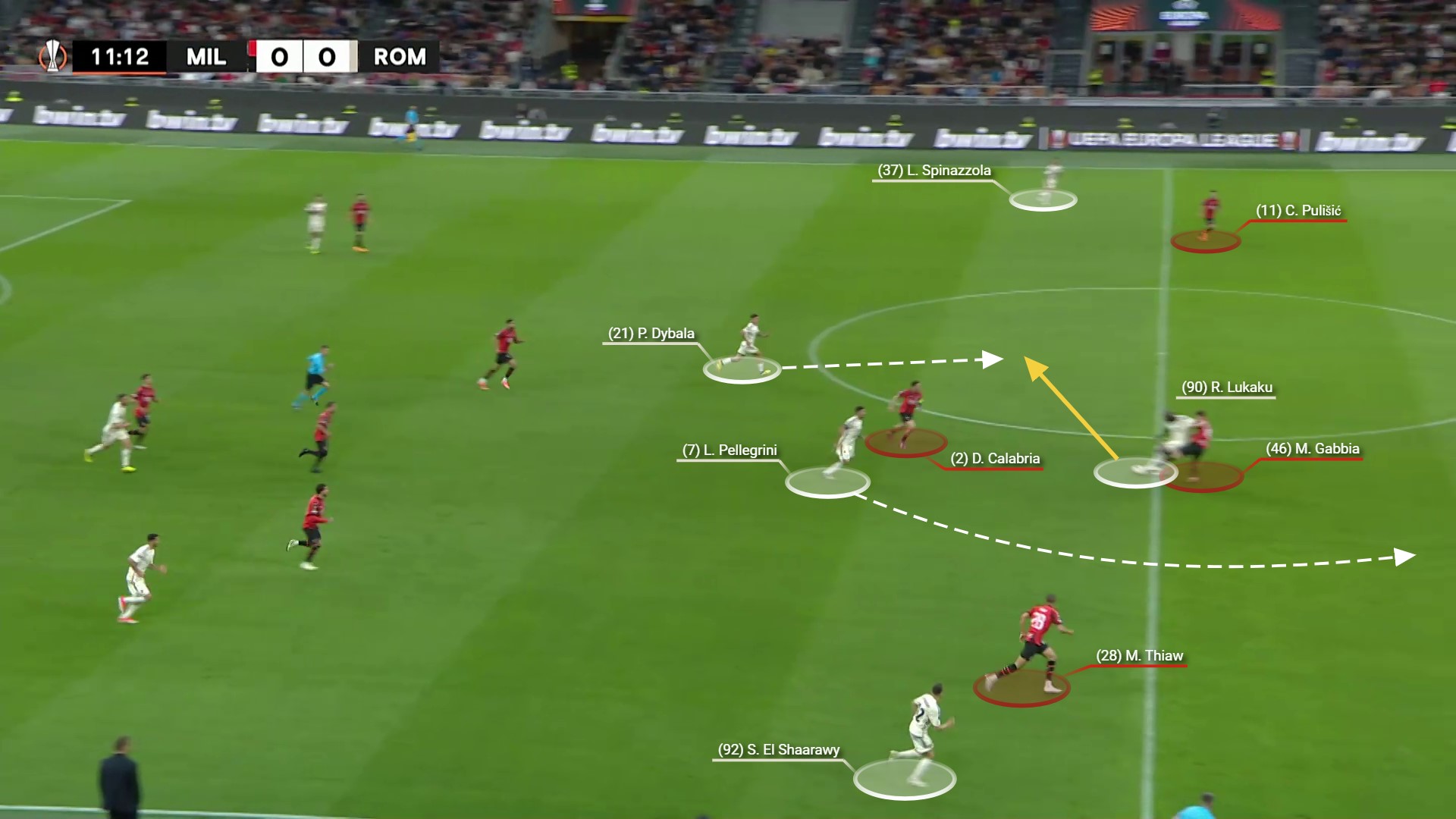
Lukaku laid the ball off to Dybala who then played in behind to meet Pellegrini’s run. The Italian looked as if he was going to get clear a strike on goal but for a last-ditch tackle from Calabria who tracked and recovered well.
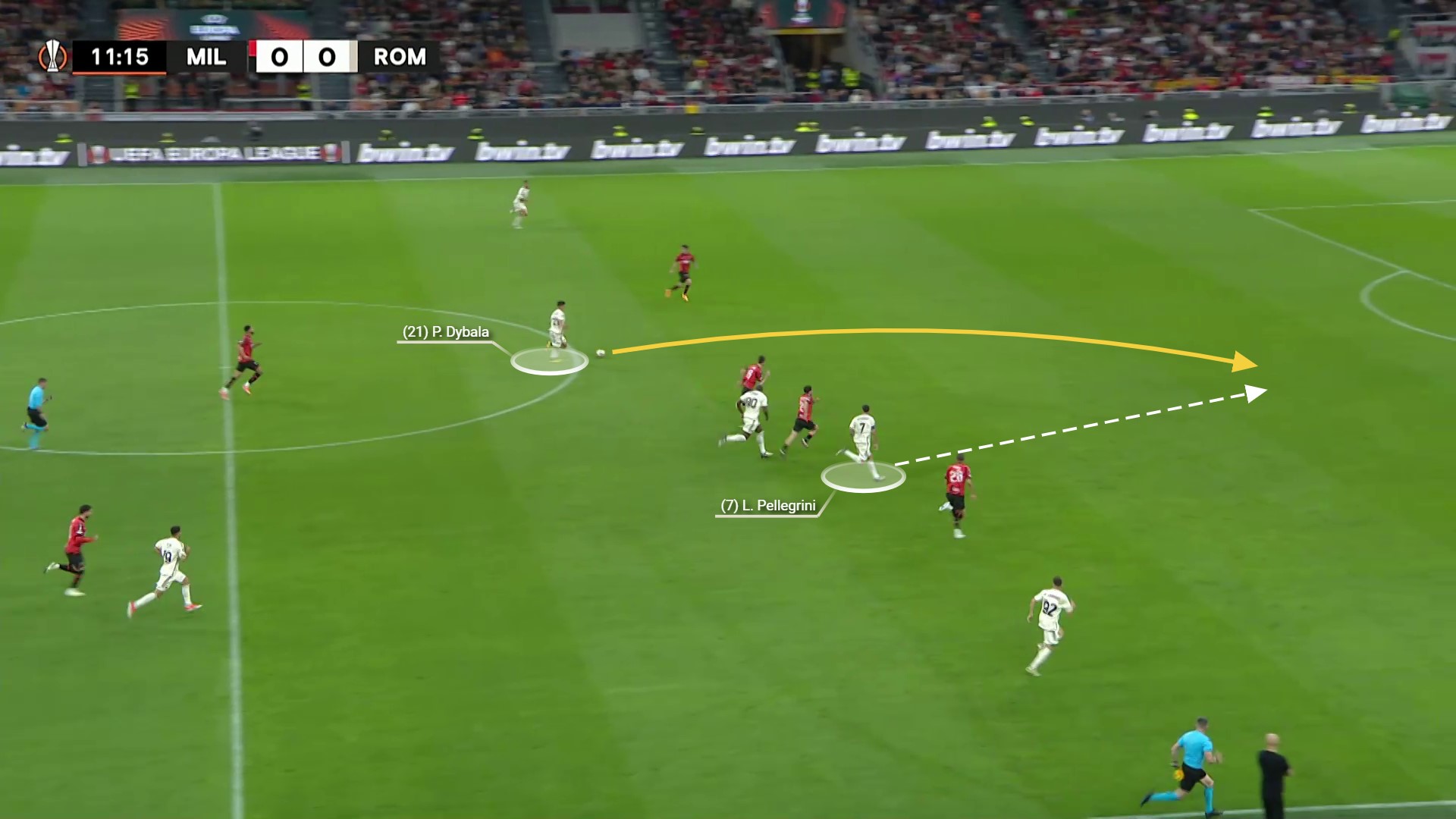
As seen in the previous examples, Roma were happy to recycle – in essence, restart – their possession sequences back towards their goalkeeper and own third. This is because it helped drag Milan up the pitch and potentially create new opportunities to execute their attacking gameplan.
Here, early in the 16th minute, this is exactly what happened. Not captured in the image below are the movements Cristante made towards, and passes exchanged with his goalkeeper. Both of these factors helped attract Reijnders towards him, freeing Çelik in the process of receiving a clipped pass from Svilar.
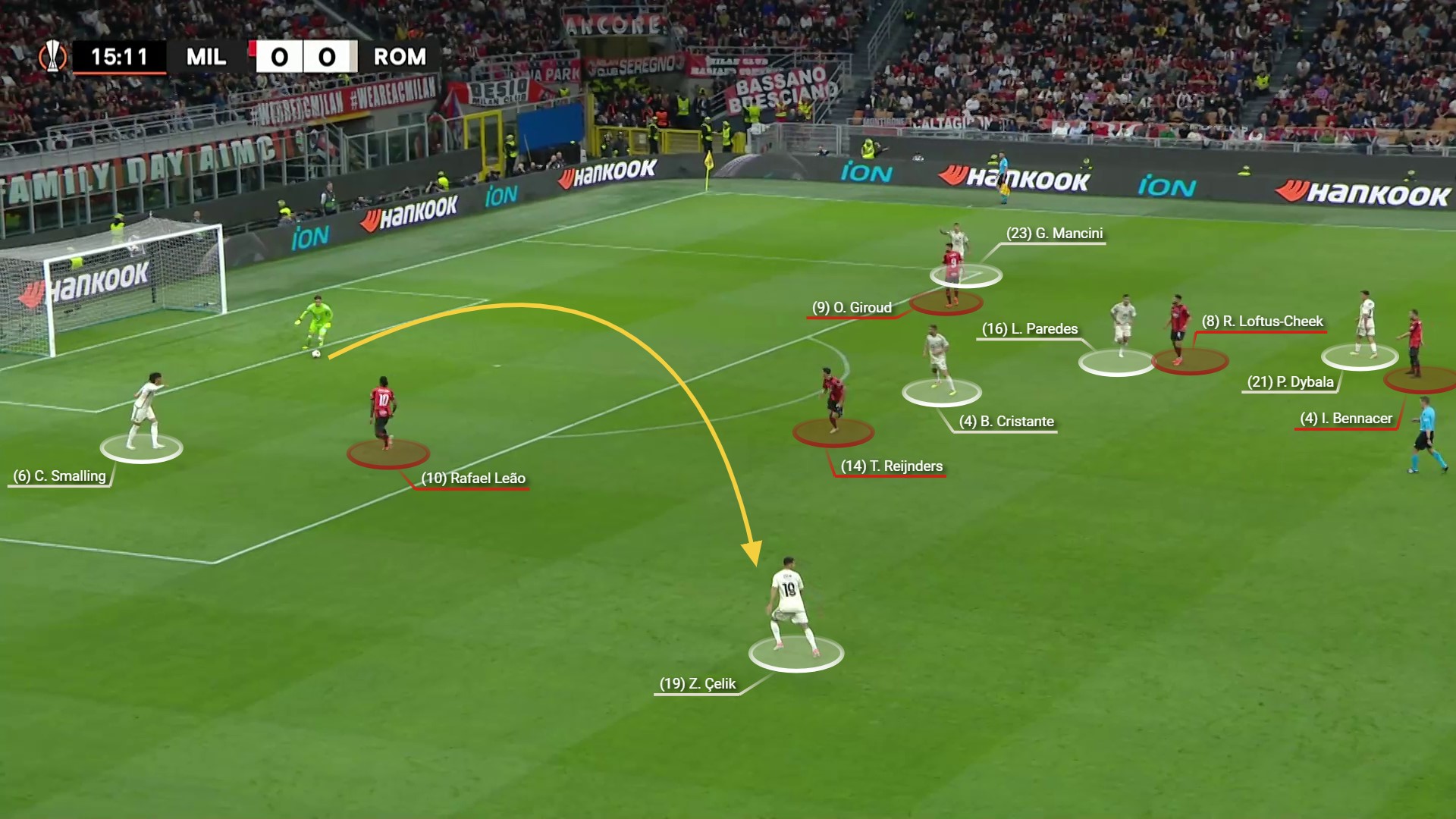
The Roma right-back was again closed down by Theo Hernández so immediately flicked the ball on towards the free El Shaarawy. In this sequence, Lukaku had drifted onto the outside of Thiaw which (presumably) prevented him from picking up the opposition right winger.
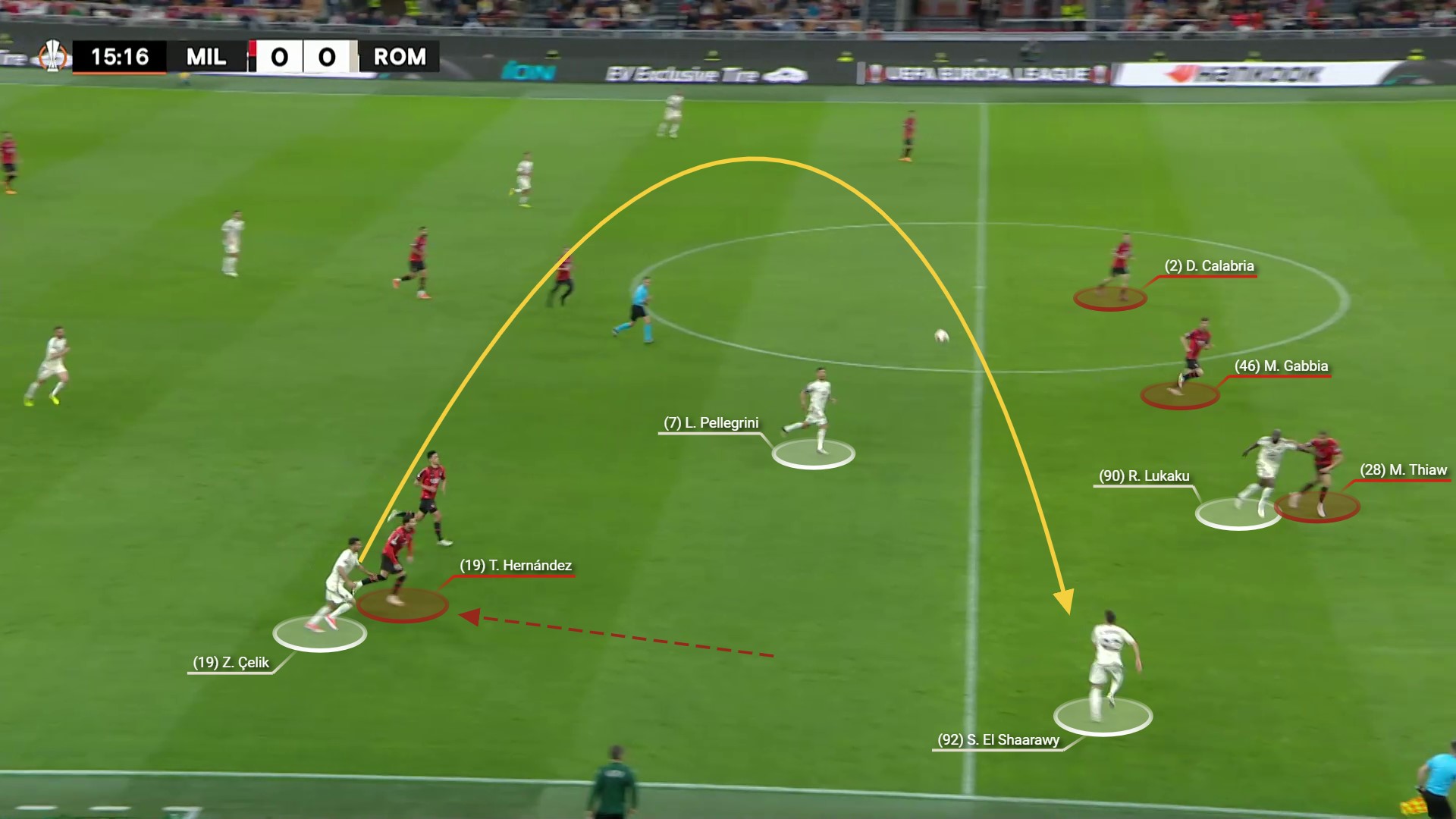
As a result, El Shaarawy was able to control and then easily play a pass into the channel for Lukaku to run onto. It was this pass which Milan considered to be offside but play continued.
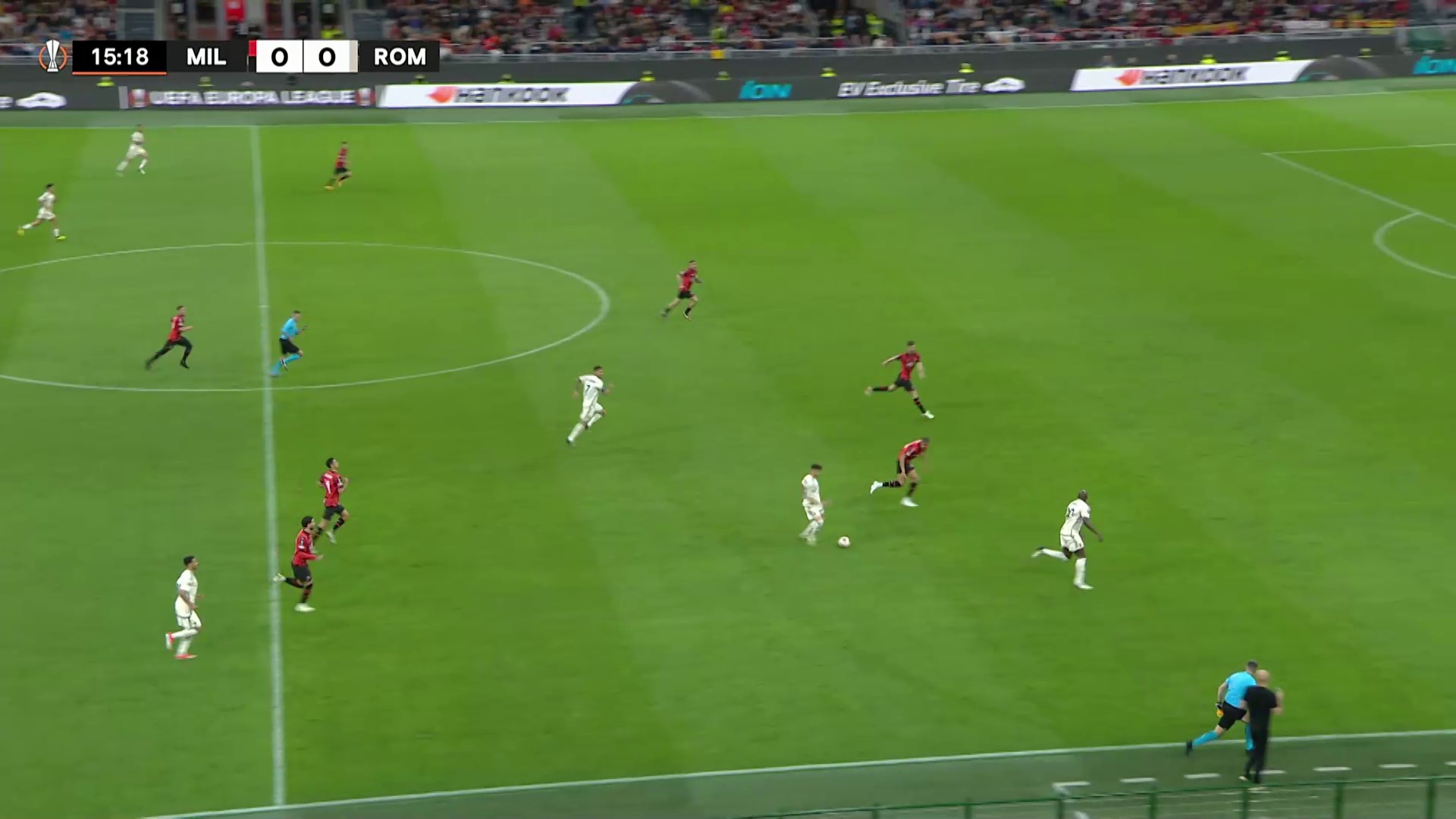
From here, Lukaku cut the ball back for El Shaarawy to shoot inside the box. Whilst this shot was deflected, it did force a fingertip save from Mike Maignan. A corner kick was conceded and from this take, Gianluca Mancini evaded his marker to head home and make it 1-0 Roma.
After going a goal behind, Milan took control of the game. For the remainder of the half, the home side dominated possession (over 60%) and went on to generate a further 10 attempts on goal, compared to only three from Roma (all at the end of the half). But Roma proved to have just as an effective game plan defensively as they did offensively.
The visitors dropped into a compact 4-4-2 block without the ball and were content to allow the hosts possession in front of them. De Rossi’s side demonstrated how well drilled they were as a collective and in units, with players seamlessly covering for each other to plug any gaps which appeared in their shape. This helped limit Milan’s open play chance quality in the opening forty-five minutes, with the hosts’ most threatening attempts coming from set-pieces.
Despite Roma having less of the ball during this period, their attacking tactics still caused Milan issues. Here’s an example from the 27th minute where Dybala himself is the deepest central midfielder. From this position, and by attracting Reijnders towards him, the Argentine was able to find an easy build-up exit to Çelik at right-back…
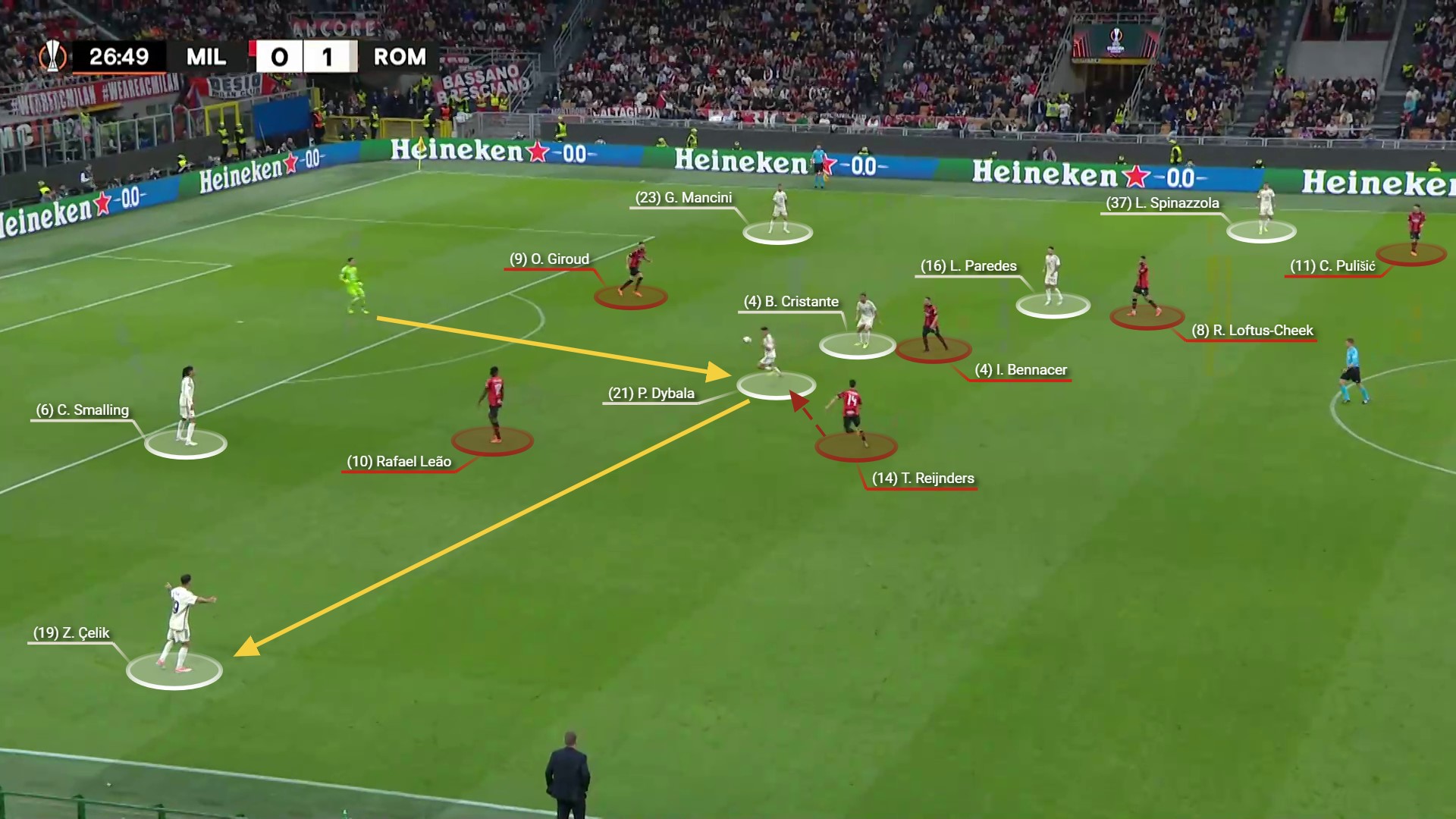
…who then proceeded to progress the ball upfield with no Milan player jumping up to engage him. This allowed for a pass down the line for El Shaarawy who whipped in a dangerous cross that Lukaku failed to get on the end of.
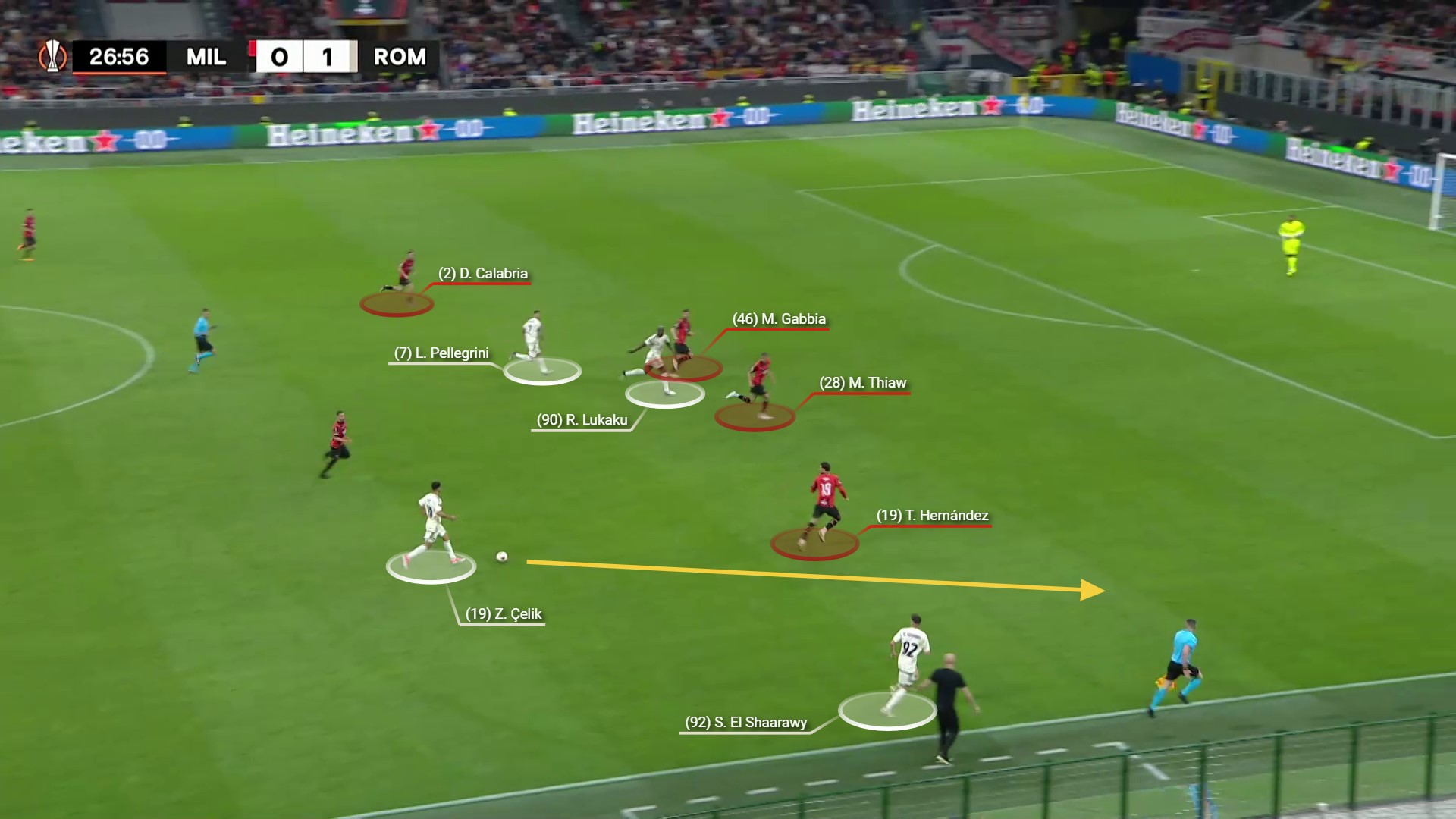
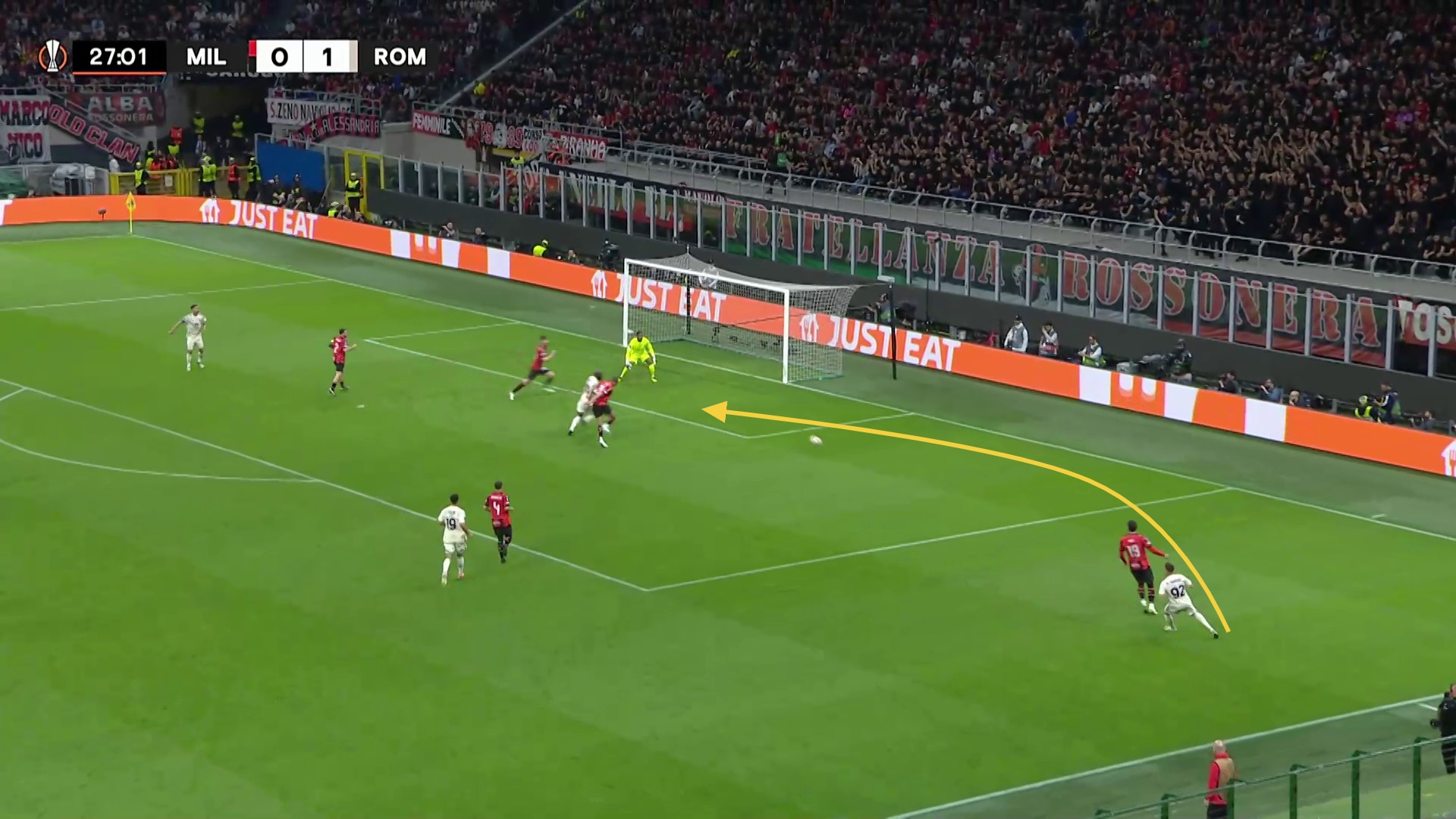
If there was to be a single image which summed up the defensive difficulties Roma caused Milan in the first half then it’s the one below. Dybala dropped in behind the opposition midfield, with the Milan centre-backs recognising (see Thiaw pointing) but unsure whether to jump up and cover or stay connected against the force that is Lukaku.
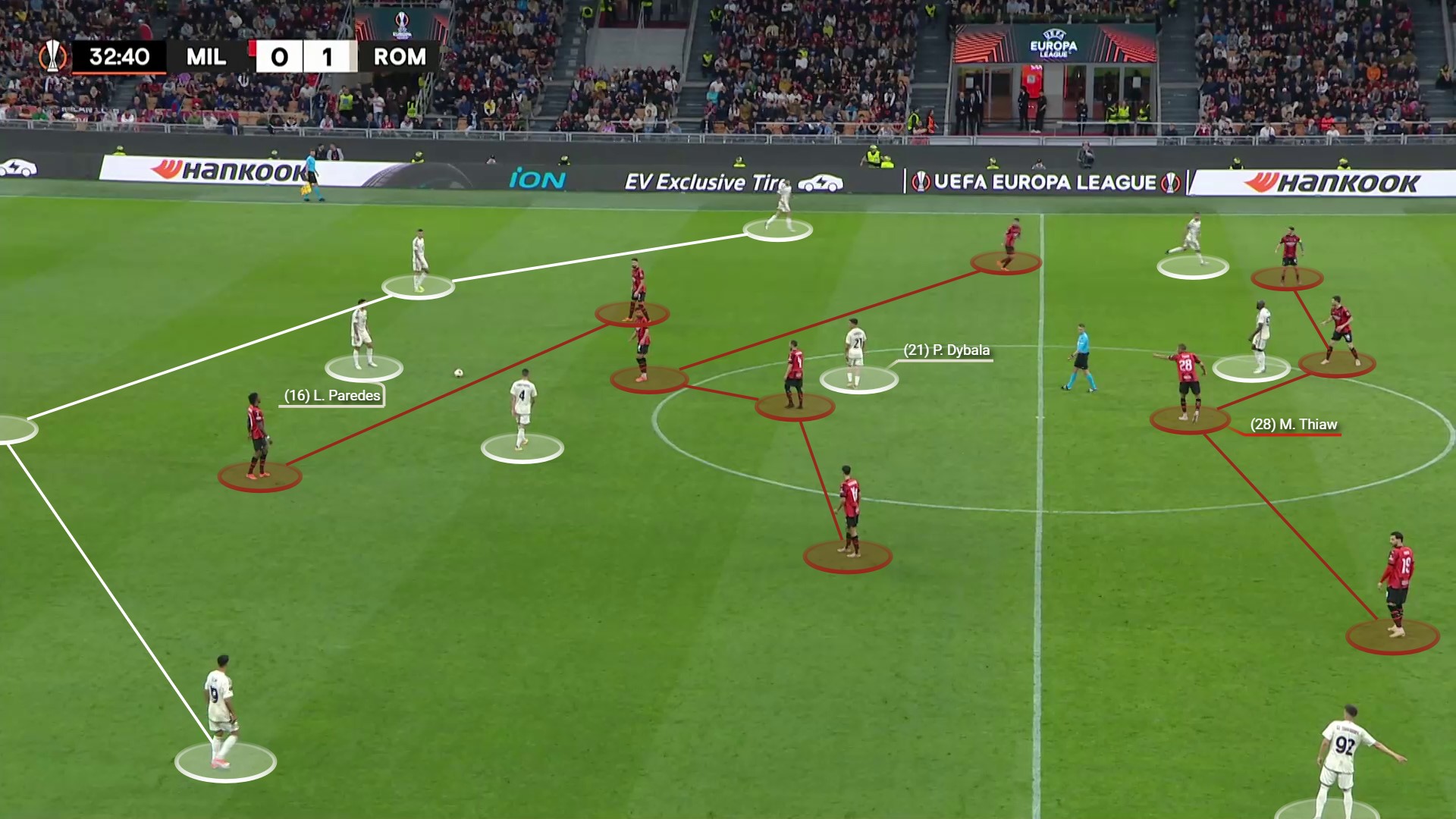
And whilst Milan may (quite rightly) still question the offside which led to the corner kick they conceded from, the Rossoneri can have no complaints about who the better side was in the first half. De Rossi’s gameplan, both with and without the ball, and his side’s execution of it, more than justified their 1-0 lead.
Second half tweak
At the break, Pioli undeniably looked to correct the issues in his side’s defensive set-up. The evidence could be seen as early as the 47th minute.
From a Roma goal kick, Leão was now in his more familiar left-wing position, covering Çelik. As Giroud tried to split the two opposition centre-backs, he was joined – in the team’s pressing scheme – by Loftus-Cheek. This meant that Roma’s double pivot was now exclusively the responsibility of Bennacer and Reijnders.
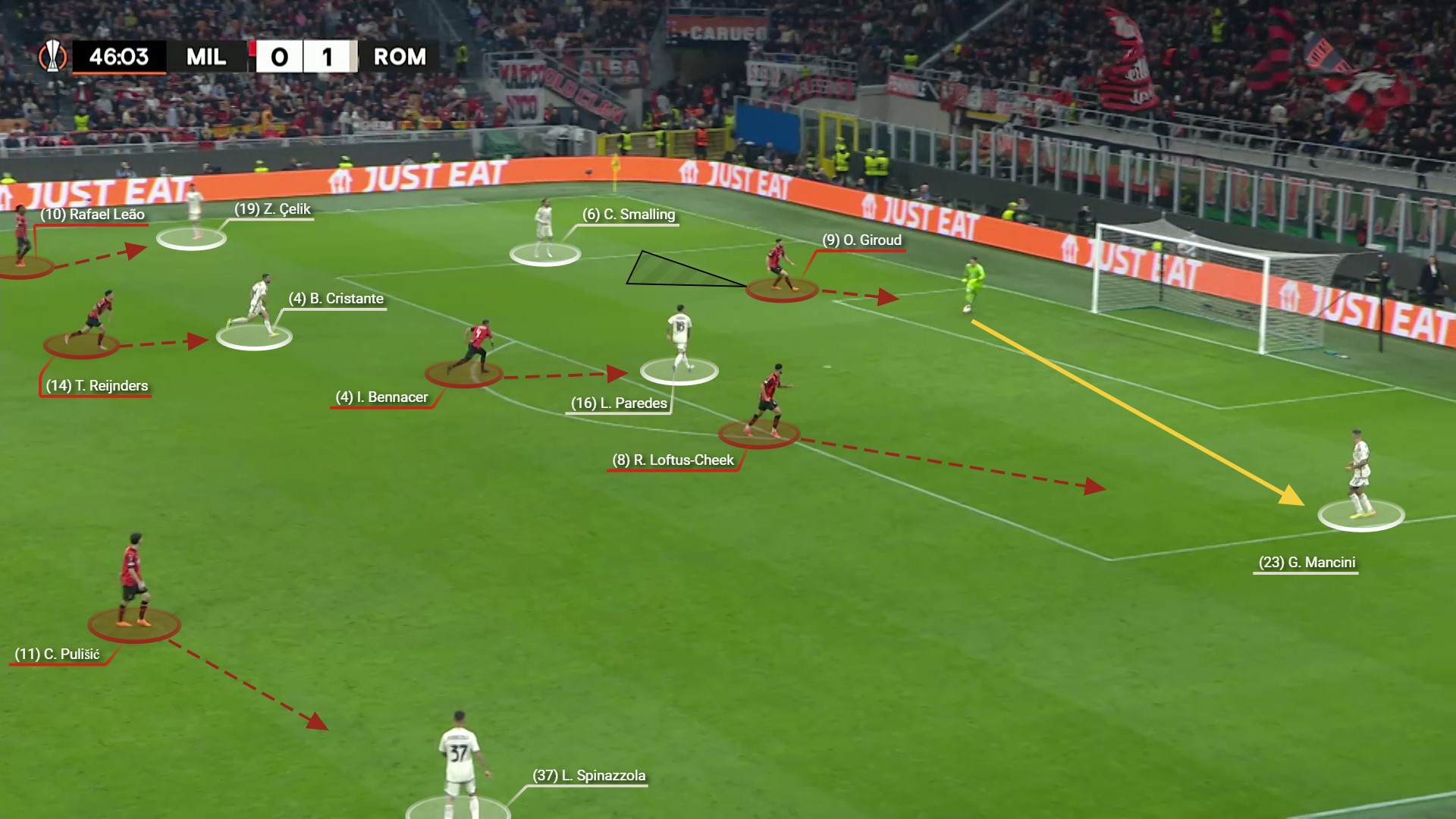
But with all the Milan midfielders now elsewhere occupied, who therefore picked up the responsibility of covering Dybala? Well, that task was alternated between the Milan centre-backs.
It was a risk-versus-reward tactic, however, as whilst this adjustment benefitted the home side in this specific scenario – Gabbia’s higher position enabled him to pick up the loose ball after the Milan high press forced Roma into a rushed forward pass. The risk factor was, as you can see below, it left Milan in 1v1 situations at the back.
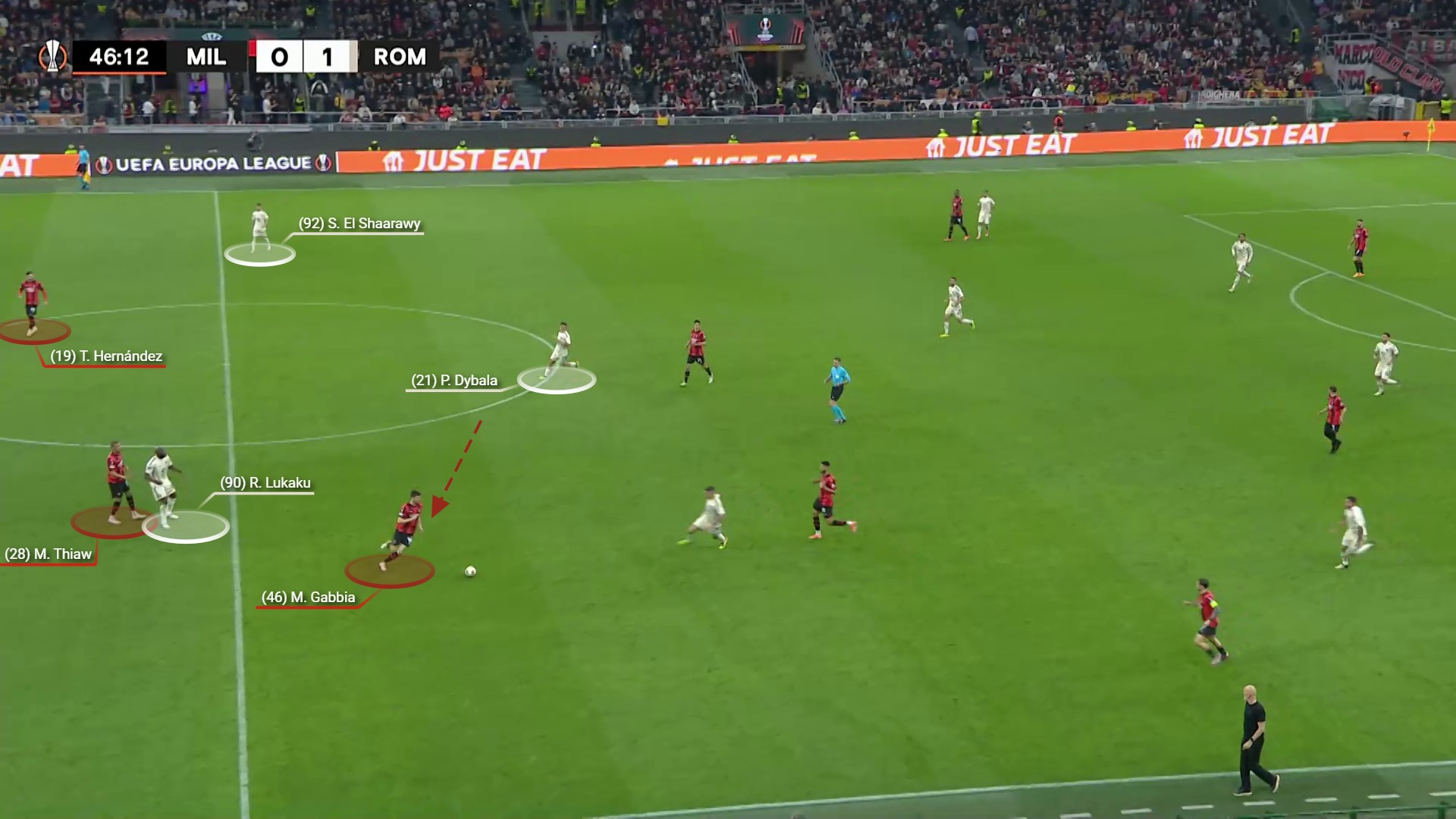
On the whole, this more aggressive and front-foot approach from Milan paid off. In the second half, Roma were limited to three attempts on goal and none of any real danger.
Even on the occasions where the home side’s high press was bypassed, like here in the 52nd minute, they managed to deal with the situation. In this passage of play, note how high Thiaw had pushed up out of the backline to cover Dybala.

Even though Milan actually forced an initial turnover in this situation, Roma managed to regain the ball and then play forward to Lukaku who was 1v1 against Gabbia. However, the Milan centre-back managed to win this duel, conceding a throw-in which allowed his teammates to get back in shape.
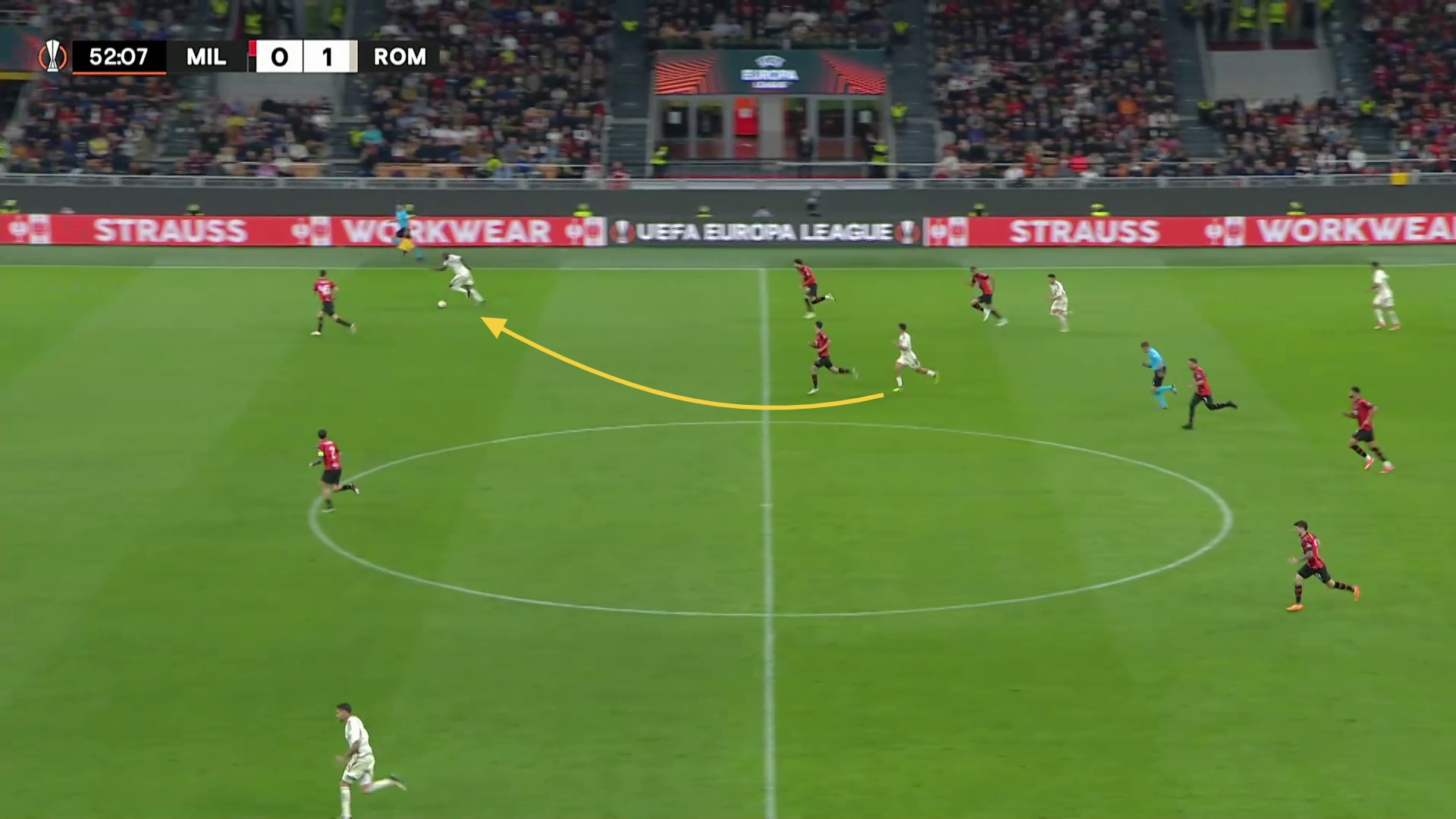
Milan’s increased intensity without the ball continued throughout the second half. And the benefits were not only defensively, with the team’s regains helping create attacking opportunities too. In this example from the 74th minute, the Milan high press forces Roma back to their goalkeeper.
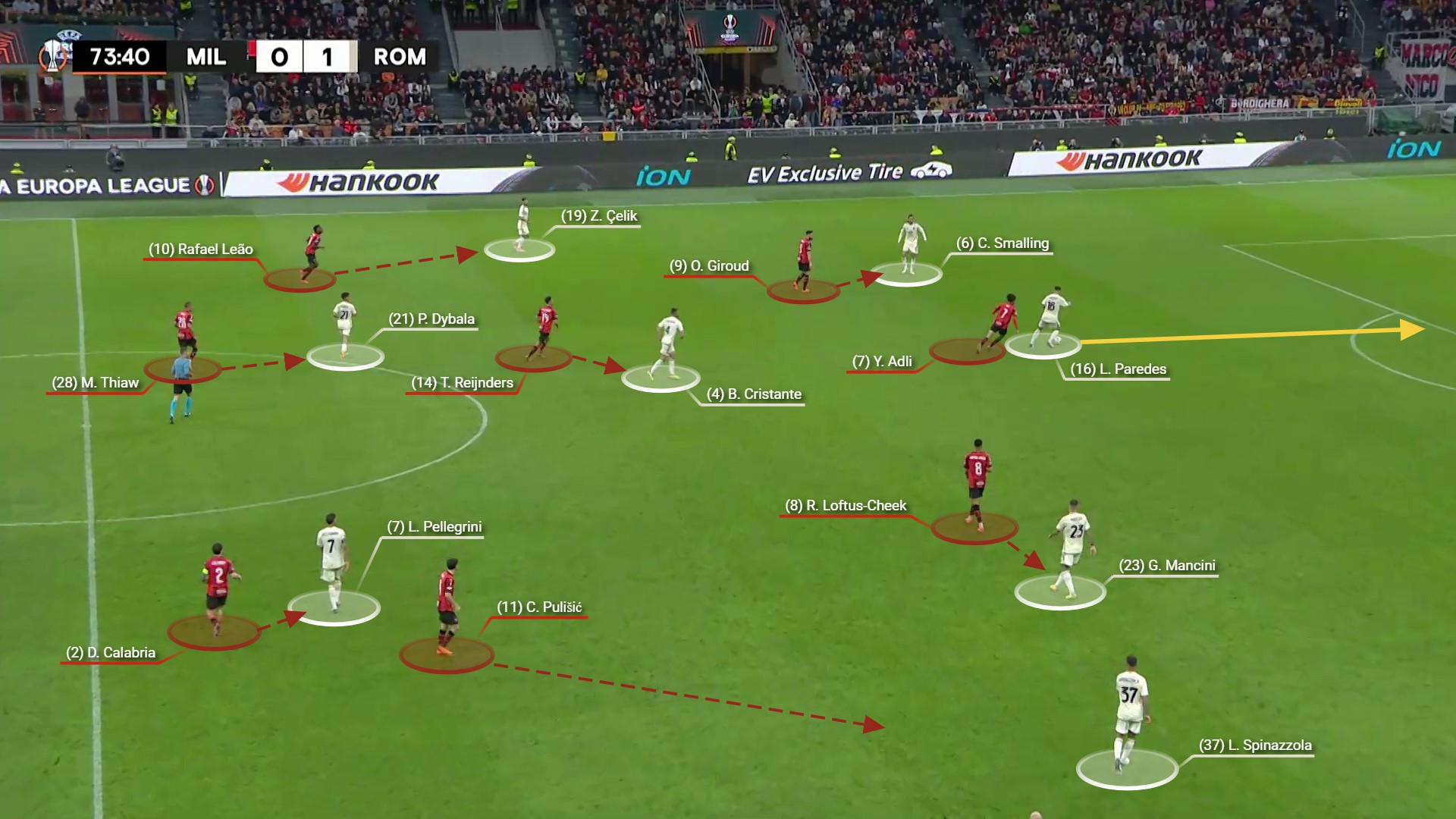
But the pressure did not end there. Substitute Yacine Adli continued to close down Svilar, blocking any passing lane into the opponent (Paredes) he was previously marking, and with no short passing options available, a long pass was forced which went out of play. From the restart, Milan initiated an attacking sequence which led to a shot and the winning of a corner kick.
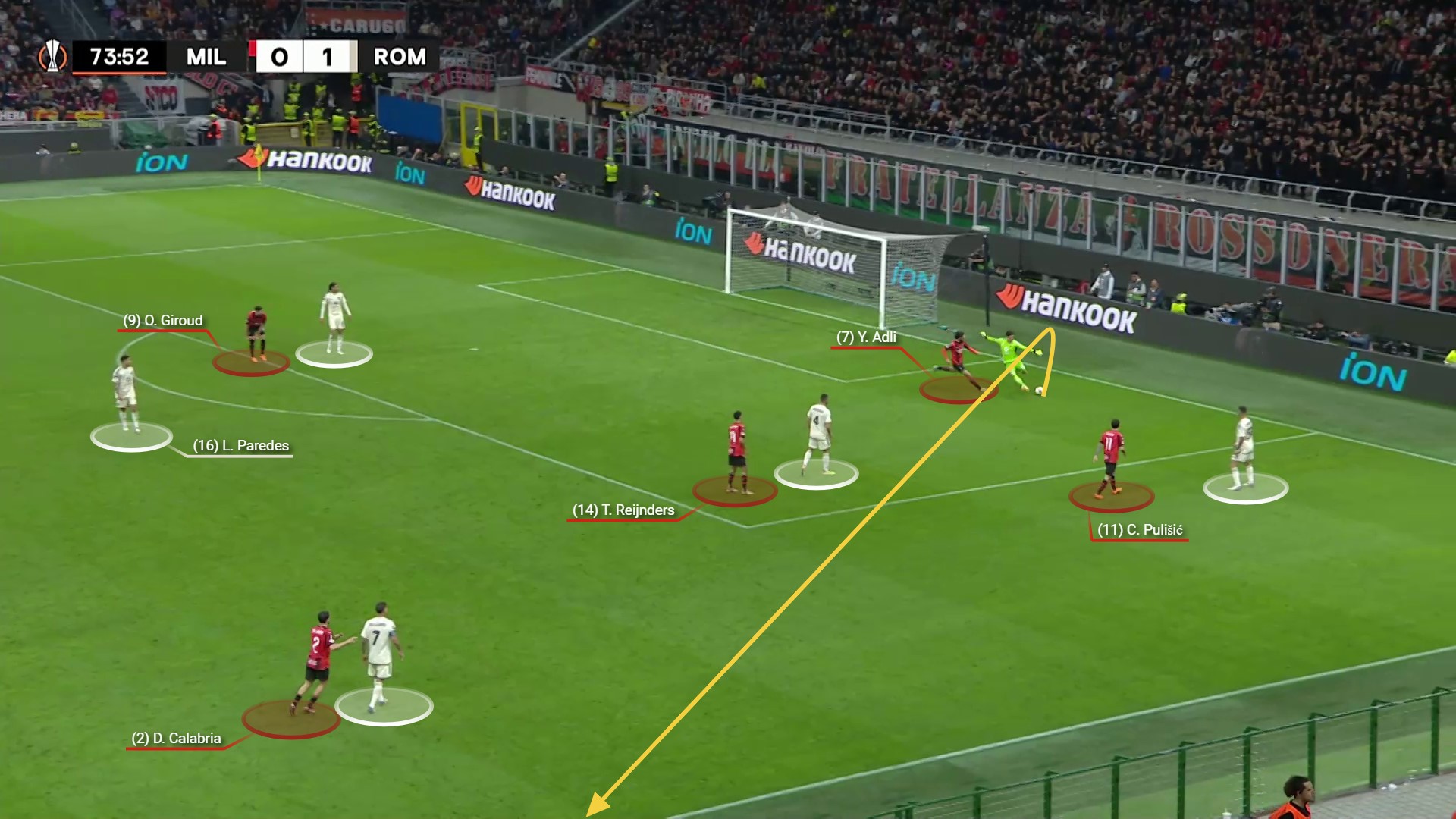
In the second half, the home side’s PPDA (Passes Per Defensive Action – a proxy for pressing intensity) was 7.9, a massive jump compared to their 14.2 in the first half. Granted Milan were unable to find an equaliser in this game but Pioli’s half-time tweak was certainly needed and helped change the momentum of the game.
Credit must also be due to Roma who continued to defend resolutely after the interval, restricting their opponents to more long-range efforts. It required a real team effort from the visitors, with Lukaku playing his part. The Belgium forward helped relieve spells of prolonged pressure with his hold-up play, winning fouls and getting his side up the pitch.
The Rossoneri will undoubtedly feel the result is harsh, given the potential offside before the goal, the Tammy Abraham handball appeal and Giroud’s golden opportunity to equalise late on. But the tie is still very much in the balance and Milan now know what they need to do, and improve, to progress next week.
Ahead of that, it’s Sassuolo in Serie A on Sunday, where three points will be expected, even with a rotated side.

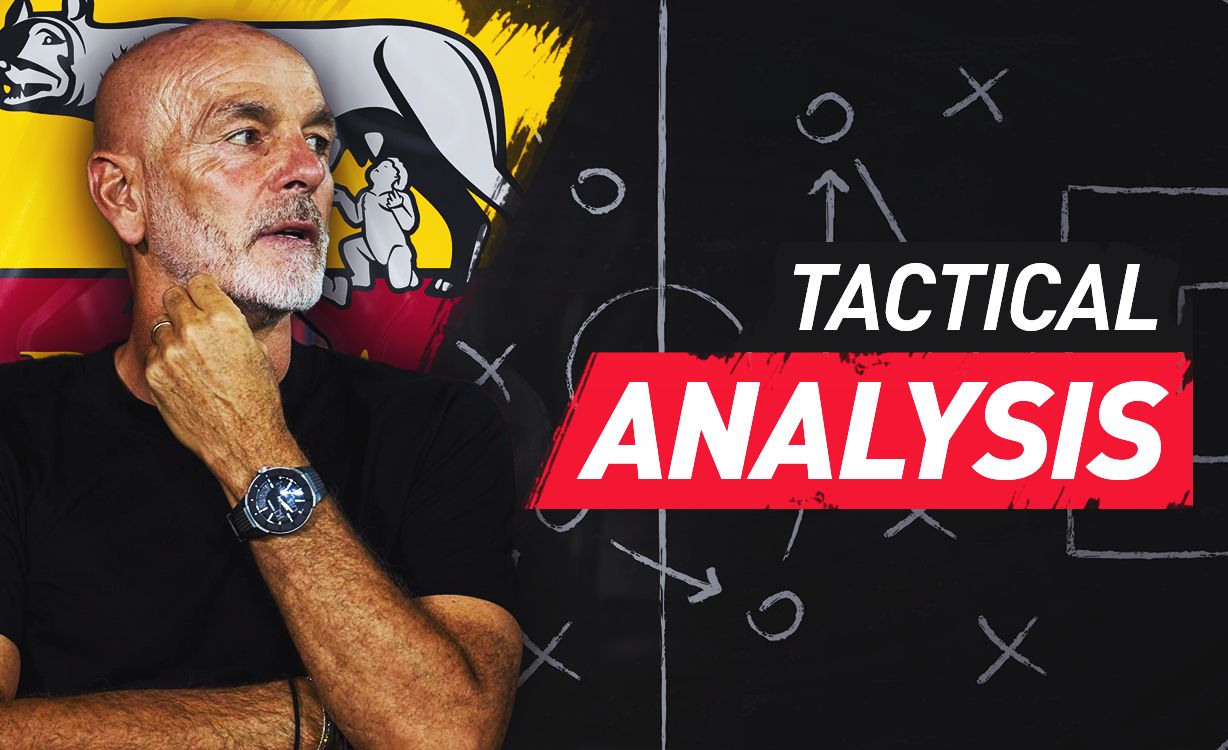

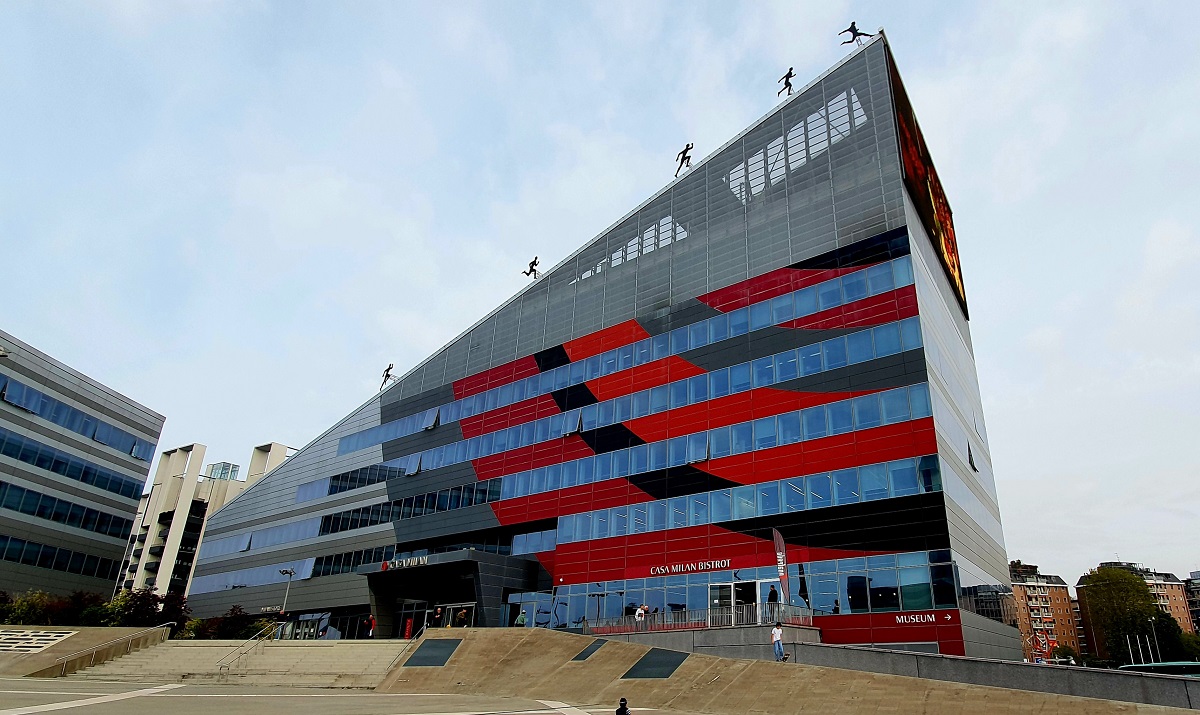

Sack Pioli at the end of the season. Period. He is not a good tactician. He won the scudetto because of Ibra.
No, Leão can’t press. He must know what will be the dangerous pass(pass into the center back or a pass to the midfield).
Did Dybala drug our team?
Would I say Tomori’s absence cost the defence in the 1st half?? Lukaku is big and quick, so Gabbia has to help Thiaw out in marking him, this leaves roma with an extra free man (Dybala or Celyk)